Jody Miller wins silver at F3J at World Chapionship
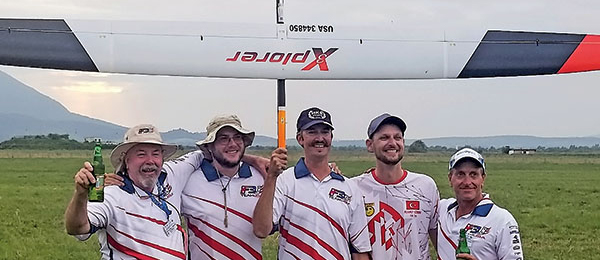
Written by Gordon Buckland RC Soaring Column As seen in the November 2018 issue of Model Aviation
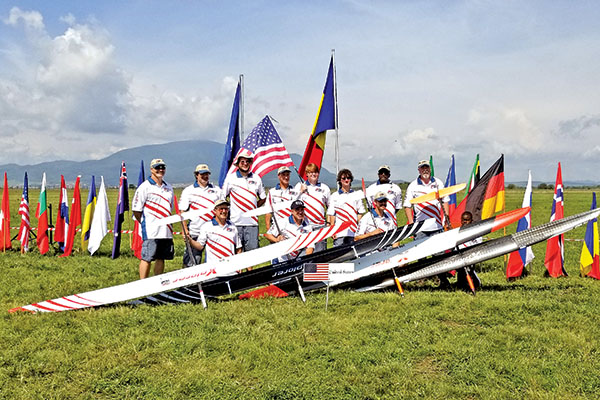
Team USA F3J in Brasov, Romania (L-R): Kelly Johnson, David Kalamen, Bob McGowan, David Bradley, Josh Glaab, Neal Huffman, Luke Glaab, Stoil Avramov, Jody Miller, Charles Thomas, Gordon Buckland, and Charleston Thomas.
The FAI F3J World Championship for Model Gliders is conducted biennially. Teams from around the world gather for two weeks to compete for the honor of becoming champions in our sport. July 22-28, 2018, saw this prestigious event take place in Brasov, Romania, with 46 Senior pilots representing 16 countries. Junior pilots had teams from nine countries, with 21 people competing. Team USA consisted of Bob McGowan, from the Central Valley Radio Control club in California; Neal Huffman, from the Eastern Soaring League (ESL); and Jody Miller, who flies with the Orlando Buzzards in Florida. Three Juniors also traveled to Romania and represented the US: Stoil Avramov, of ESL; Luke Glaab, also of ESL; and Charleston Thomas, from Knoxville, Tennessee, who was the youngest pilot at 12 years old.
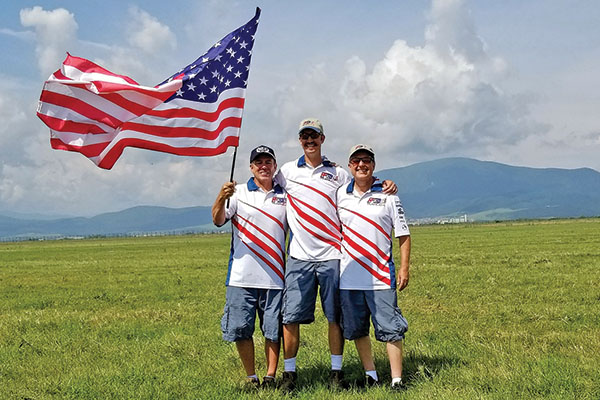
The three Senior pilots (L-R): Neal Huffman, Jody Miller, and Bob McGowan, after the opening ceremony for the 2018 FAI F3J World Championship.
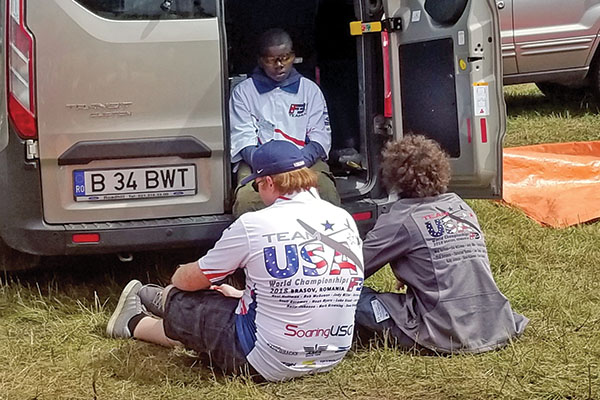
The three Junior pilots conduct a powwow during the preliminary rounds. (L-R): Luke Glaab, Charleston Thomas, and Stoil Avramov.
The contest venue was Aeroclub Brasov, which is situated 15 minutes from the bustling city. The Brasov airfield is shared with the manufacturing facility for Airbus Helicopters. Limited light-aircraft operations continued from the adjacent airstrip during the competition, which was a surprise to us because aircraft took off toward us and flew low over our heads on multiple occasions. The weather varied each day, with calm, foggy conditions in the early morning, transitioning to easy thermal flying until approximately midday, when it would often rain, storm, and/or blow up to 14 mph wind, making thermaling more difficult. Few pilots survived the week without dropping a flight, and those who maxed all of their flights easily made the flyoffs.
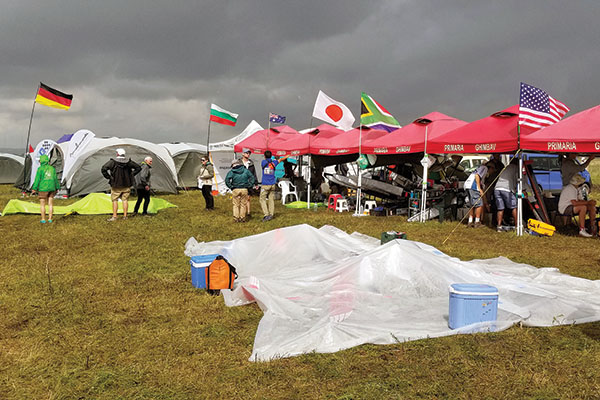
The sailplanes needed to be covered nearly every day. Dawn Huffman videotapes the approaching storm as the teams hunker down under the tents.
The US team arrived two days early to acclimate themselves to the field and practice hand tows and launching, which is different from the F3B winch towing that we do in the US. Some models needed setup changes, and although storms decreased time on the field, much was accomplished. On Friday, July 20, the first competition was the Romanian Cup, which is a precontest event to test all of the systems. It allows the pilots to prepare for the field and conditions. The competition lasted two days, with just two flyoff rounds. It was a good workout for the team members and their towers.
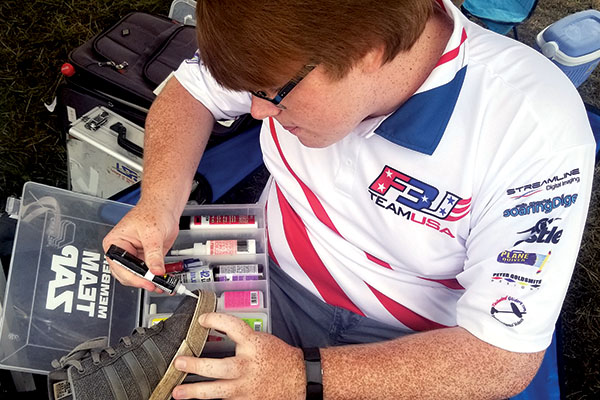
Luke Glaab uses a Zap glue repair kit to make running repairs on his sneakers during the contest.
Jody Miller, Stoil Avramov, and scribe Gordon Buckland made the flyoffs. Stoil starred as the top Junior and the only one of four pilots to get his time in the second flyoff round, placing fourth. Gordon came in sixth place, and Jody in 11th place after he landed out in the second flyoff round. With the precontest over on Saturday and registration completed on Sunday, a short opening ceremony was conducted at the field. Then the real contest got underway. The US team planned to be conservative, take no chances, and finish the preliminary rounds with a clean slate. It was a good plan, and for the most part, it paid off. As with all plans, however, something unexpected often gets in the way. The first round saw safe flights for Neal and Jody, but Bob got the launch monoline wrapped around his sailplane’s nose and had to land and launch his second model for an 8-minute flight and an 869-point score. This was unfortunate, and the drop in the first round was a real worry for him but, as only Bob can, he came back with 1,000 points in round two. Day two was foggy, but the fog wasn’t as heavy or as low as what we had experienced on the first day. Making safe flights with full launches was still our theme, and this worked well through round three, with each US pilot maxing with good landings.
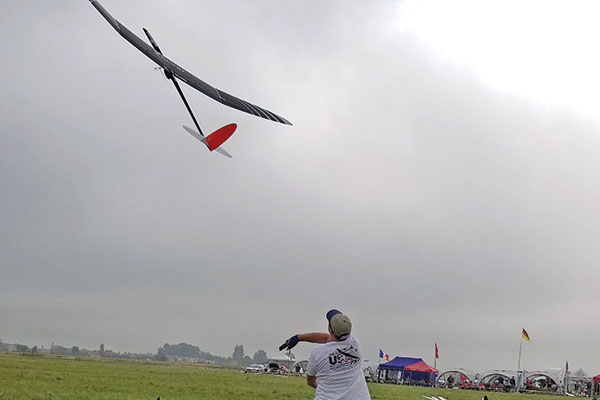
Kelly Johnson was a real workhorse and threw sailplanes throughout the contest. Here he launches a model during practice before the flyoffs.
Sometimes things don’t go as planned. In our case, the difficult stormy afternoon conditions with rain, wind, and weak thermal activity eventually caught up with us. In round four, Bob landed out and had to relaunch for a 594 score, making the remainder of the contest difficult for him. The Seniors flew four rounds on day two, for a total of six completed rounds, and the Juniors finished day two with round four. Stoil led the way, finishing day two in third place, with Luke in 16th, and Charleston in 19th after landing out at 8 minutes. The Senior standings saw Jody climb into the second position, with Neal in sixth place and Bob in 22nd. Despite the difficult flying conditions, we felt that the team was in a strong position going into day three, with the throw out kicking in after eight rounds.
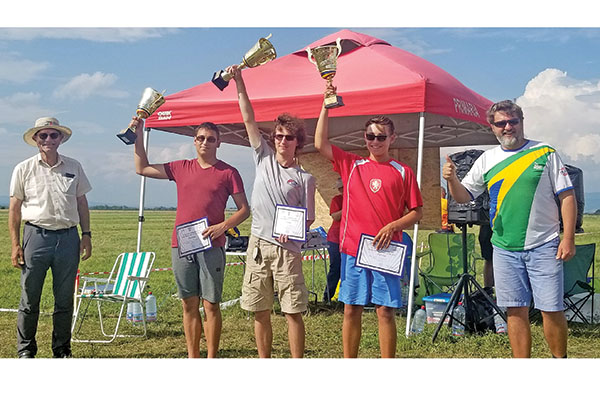
Junior pilot Stoil Avramov placed fourth in the Romania 100 precontest and was the US first-place Junior pilot. He is seen here (center) with his spoils of victory.
“Steady as she goes” saw the US Senior and Junior pilots navigate two more rounds on day three, with excellent-scoring flights to consolidate our position. By the end of day three, Jody had posted three 1,000s in a row, firming him up in third place, with Neal close behind in fourth place. Round nine, unfortunately, saw Bob in trouble in difficult conditions. He landed out and had to relaunch for a 4:04 flight and another drop in a group, where only three pilots maxed the 10 minutes. We all felt for Bob because his confidence was already under assault and he couldn’t catch a break. He seemed to draw the worst thermal conditions in each of his rounds. The day concluded with the US Junior fliers all maxing and moving into second position as a team. The Senior team moved up to third place. Day four was less cloudy, but rain was forecast again for the afternoon. Two rounds of the Senior class flights were completed without the US team missing a beat. Neal and Bob made epic flights in front of an approaching storm, and all of the pilots nailed their landings for great scores. Bob’s flight was an absolute “pearler” because he used his skills in ridiculous conditions to take us into the second team position. Neal finished day four in third place, with Jody in fourth. It was a huge moment at the completion of Jody’s round 13 flight. With only one round to fly the next day, he qualified for the finals, even if he took a zero on Friday in the 14th and final preliminary round. Jan Littva, the 2014 World Champion, was in first position. The Juniors struggled a little. Luke flew hard in round 12 but finished a couple of minutes short. These were valuable points, though, because the Juniors could finish on the podium with a strong showing on the final day. It was with subdued excitement that we prepared to fly on Friday, knowing that we only needed three solid Senior flights to take second place in the Team competition. For the Juniors to take third place, they also simply needed to make their times and get a landing. Jody and Neal got their flights out of the way in buoyant air, and with one flight to go, we waited in anticipation as Bob took his final launch. Inexplicably, the model never hooked up, went out on a flat trajectory, and came off the hook at approximately 50 feet. He tried desperately to save the flight, but it was to no avail. He finally landed out at 7:30 into the flight. It was one of those excruciating moments that words cannot describe. Our emotions went from the high of a second-place finish to the low of “also rans.” So ended our Team USA campaign, which promised so much but finished so miserably for Bob.
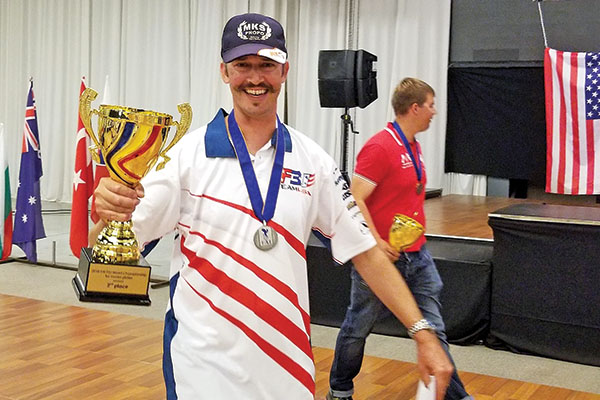
Jody Miller beams as he returns from the podium with his silver medal and gold cup.
Hindsight is a wonderful thing, but we should never have let him fly his lightweight model in that important round 14 because it was not properly set up after having to change the horizontal stabilizer before the contest started. The final positions after the preliminaries were Neal in third, Jody in fourth, and Bob in 38th, with the team in fifth place. The final two Junior preliminary rounds were flown with Charleston demonstrating thermal skills beyond his age in both rounds and in light air to max and score landing points. Stoil took the 1,000 in his final round, but Luke drew some tough air in his group and eventually fell short on time after a great fight. The final positions had Stoil in eighth place, Charleston in 12th place, and Luke in 15th place. The boys flew well, and it was a pity that they finished just off the podium in fourth place. The flyoffs were conducted after a short break, with six 15-minute rounds scheduled with the top 12 pilots in the Seniors and the top 10 in the Juniors. They started in decent conditions but without a good read, Jody and Neal both took long launches and maxed with 14:57s to make a good start. Neal had a midair, which significantly damaged his center section, but we used CA glue to repair it for him to fly in round two. The second round was started with an obvious thermal just passing by. For the first time during this campaign, I tensioned Jody heavily for a rocket launch and direct tow, and he was off as soon as I threw. Unfortunately, we forgot to warn our official timer of the fast launch and he was a second slow on the button, but Jody followed the lift quickly downwind, hooked up, and maxed with a 100 landing, scoring well with a 998.8. Neal also stayed in the hunt. We had a good read in round three and again elected to rocket launch. Jody did an excellent job with his 3.5-meter Xplorer—hooking up and running a long way downwind to max—but he missed his landing. His 14:58 and 97 landing scored 997 points and was most likely the flight that would clinch his podium position. Round four conditions were cooler, windier, and clearly more challenging, so Jody and Neal both took longer tows (as did the entire group) and completed uneventful maxes. Round five saw us in ever-so-light conditions, following weak lift by walking west and finishing the thermal portion of the flight more than 200 yards off the field in a cow paddock with Arijan Hucaljijk and his caller, Carl Strautins. (Following the model in this way, we are often able to complete a flight using one thermal by staying within better sight of it.) Neal was involved in another midair and fell slightly short of the full max. Looking at the scoreboard, we could see that Jody was in second place and Neal in fifth. Round six was the final round, and with merely a couple of points covering second through fourth places, we decided to stay as close to our competition (Cedric Duss and Oleksandr Chekh) as possible. They launched from adjacent lanes, so we ended up flying the entire 15 minutes in a group. We flew in the same airspace to the south over the hangar in a weak thermal, before returning for one last landing. It was a huge emotional moment as Jody made that final landing, and we knew he was on the podium. After eight years of concerted effort, long discussions, practicing relentlessly, and flying contests across the US, these two Orlando Buzzards club members were finally one rung away from being on top of the world—and it felt pretty good. Neal missed the air on his final two flights after another midair and faded to 10th place, but he certainly flew well and put up a great fight. Throughout the entire contest, he was plagued by onboard battery/switch issues, and the midairs didn’t help. The Junior flyoffs saw Stoil fight his way through all six rounds, but his contest went awry in the second round. He failed to come off of the line in an attempted short tow and his timer accidently started his clock early. Despite this mishap and a good refly that he was awarded, Stoil just was unable to make all of his times and finished in ninth place. He was the backbone of the Junior US team and flew many magnificent flights during a week that saw some of the most difficult thermal conditions that one could imagine. This World Championship was a long campaign, and although we failed to take home the team medals we strove for, it was a wonderful group of pilots and helpers with which to work, and I am proud of our accomplishments. To see Jody Miller’s smile as he stood on the podium in second place was a dream come true, and a memory to cherish forever. On behalf of Team USA F3J, I would like to thank the hundreds of supporters who purchased raffle tickets and made this team possible, as well as our many sponsors, particularly Soaring USA, MKS Servos, and Horizon Hobby, which again stepped up and provided the major support that the team needed to get to the World Championship. Thank you. Go downwind and soar.










Add new comment